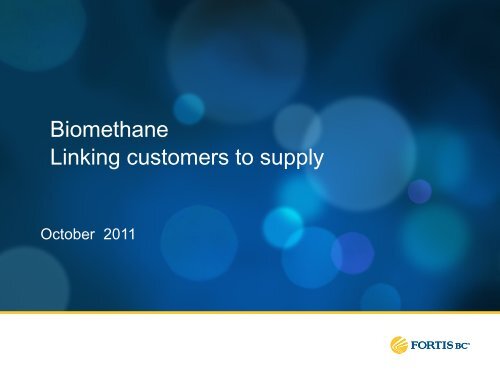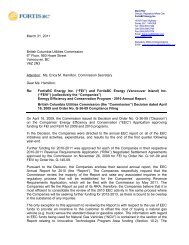Biomethane - FortisBC
Biomethane - FortisBC
Biomethane - FortisBC
Create successful ePaper yourself
Turn your PDF publications into a flip-book with our unique Google optimized e-Paper software.
<strong>Biomethane</strong><br />
Linking customers to supply<br />
October 2011
Outline<br />
1. Some market perspective<br />
2. Why renewable natural gas?<br />
3. What is renewable natural gas?<br />
4. <strong>FortisBC</strong> role<br />
5. Supply project structure<br />
6. Recommendations<br />
7. How do I get started?
Market perspective
Some perspective<br />
• Germany 1<br />
• Injecting biomethane since 2006<br />
• 70 plants expected operational by end of 2010<br />
• 4300 biogas plants total – momentum shift toward injection<br />
• USA<br />
• 31 Grid injection plants on Landfills 2<br />
• Limited number of dairy and other<br />
• Canada<br />
• Union Gas/Enbridge – Application this fall to regulator<br />
• Gaz Metro – actively evaluating grid injection<br />
• 1. Dena – Biogas Grid Injection In Germany and Europe<br />
• 2. US EPA, LMOP Website
Why renewable natural gas?
Why renewable natural gas?<br />
• Demand from customers<br />
• Customers in BC expect utilities to play a role in sustainability<br />
• RNG is a way to provide a new way for customers to make a<br />
contribution to GHG reduction<br />
• Cooperate with BC government energy policy<br />
• Practical way to make energy policy a reality<br />
• Climate action goals GHG’s<br />
• <strong>FortisBC</strong> is right for the job<br />
• An area for investment and growth<br />
• It is a natural extension of existing competency<br />
• Part of a company shift to become an energy company
Market research results<br />
Should <strong>FortisBC</strong> offer a<br />
biogas program?<br />
• Residential:<br />
• 65% Yes<br />
• 30% Maybe<br />
• 1% No<br />
• Commercial<br />
• 71% Yes<br />
• 22% Maybe<br />
• 2% No<br />
What type of program<br />
should <strong>FortisBC</strong> have?<br />
• Renewable Energy<br />
preferred over Carbon<br />
Offset<br />
• 2.8: 1 for Commercial<br />
• 3.2: 1 for Residential
Strong market potential for a user-pay<br />
renewable energy-based program
Product offering<br />
• Residential first – increase reach & participation<br />
• Eligible customers designate 10% of the natural gas their households use as<br />
renewable natural gas.<br />
• This option will cost an extra $0.53 GJ or $4 per month<br />
• The additional cost helps support biogas projects that <strong>FortisBC</strong> undertakes<br />
• Only the cost of gas line item will change on the bill<br />
Cost of gas as of Apr 1, 2011 (adjusted quarterly) $4.568 GJ x 90%<br />
RNG cost as of Jan 1, 2011 (adjusted annually) $9.904 GJ x 10%<br />
RNG rate subtotal: $5.102 GJ
Benefits<br />
Feel good about contributing to renewable natural gas<br />
development in BC and reducing your carbon footprint.<br />
• Displace conventional natural gas with RNG<br />
• A single household on the program:<br />
• Reduces emissions by 0.5 tonne CO 2e per year. This is roughly equal<br />
to o diverting 400 lbs of waste from our landfills<br />
• All projects are located in BC<br />
• Prevent waste from going to waste<br />
• Collective savings of 5000 tonnes CO2e in first year, equivalent to<br />
keeping 3.8 million lbs of waste from our landfills
What is RNG (or biomethane)?
Biogas vs. biomethane<br />
• Gas generated from organic material<br />
• Primarily consists of methane – 50% - 60% typically<br />
• Potential Sources:<br />
• Anaerobic Digester (AD) Gas<br />
• Landfill Gas:<br />
• <strong>Biomethane</strong>:<br />
• Methane from a renewable source – “Upgraded Gas”<br />
Raw Biogas <strong>Biomethane</strong><br />
40% - 60% CH 4<br />
30% - 50% CO 2<br />
0% - 2% O 2<br />
>96% CH 4<br />
<strong>Biomethane</strong> is carbon neutral
Biogas<br />
Source<br />
<strong>Biomethane</strong> – a better end-use<br />
65% Loss<br />
35 % Remaining<br />
Raw Biogas<br />
9% Loss<br />
91 % Remaining<br />
Generation<br />
6% Loss<br />
33 % Remaining<br />
3% Loss<br />
88 % Remaining<br />
Transmission<br />
No Loss<br />
End Use<br />
8% Loss<br />
81 % Remaining<br />
33%<br />
Remaining<br />
Energy<br />
81%<br />
Remaining<br />
Energy
<strong>FortisBC</strong> biogas supply model<br />
Biogas<br />
Source<br />
Voluntary<br />
Customers<br />
Upgrading<br />
Plant<br />
Asset recovery costs go<br />
into <strong>Biomethane</strong> rate<br />
<strong>FortisBC</strong> may invest in “upgrading” plant,<br />
interconnection assets and main extension<br />
increasing asset base<br />
Metering,<br />
Monitoring,<br />
Odourizing<br />
<strong>FortisBC</strong><br />
Transmission and<br />
Distribution System<br />
Asset recovery costs<br />
from all customers<br />
All Gas<br />
Customers
<strong>FortisBC</strong> infrastructure<br />
• Fortis BC plays a critical role in linking supply to customers<br />
• Existing Natural Gas infrastructure is key to multiple end-uses
<strong>FortisBC</strong> role
<strong>Biomethane</strong> supply framework<br />
Project Economics<br />
• Total cost of biomethane < Approved biomethane rate<br />
Injection Location<br />
• Adequate load must located nearby *note variation between<br />
summer and winter<br />
Gas-Processing Technology<br />
• Gas Quality meets specification & technology proven<br />
Partner<br />
• Partner must demonstrate technical and business competence<br />
Risk mitigation<br />
• Business risks covered through contract terms and design
Regulatory comments<br />
External agencies<br />
• Depending on project multiple government ministries may be involved<br />
• Depending on location permits may be required from municipalities<br />
• <strong>FortisBC</strong> will be responsible for permitting related to its assets<br />
BC Utilities Commission<br />
• Two year test period approved, upgrade ownership<br />
• Supply cap: 250,000 GJ/year first 2 years<br />
• Approval to recover asset investment – two pools<br />
• Interconnection assets – all customers<br />
• Upgrade assets – voluntary customers only<br />
Regulator wants to<br />
see demand<br />
materialize<br />
Regulator cautious<br />
about utility owning<br />
gas processing<br />
equipment<br />
• Assets need to be accounted for separately (upgrading vs. interconnect)
Catalyst Project<br />
Waste Collection Digester Gas Collection <strong>FortisBC</strong><br />
Infrastructure<br />
• <strong>FortisBC</strong><br />
85-90% of<br />
Investment<br />
• Interconnection equipment and main<br />
• Infrastructure capital added to rate base for all customers<br />
• <strong>FortisBC</strong> purchases <strong>Biomethane</strong> at higher price<br />
10-15% of<br />
Investment
Catalyst Project<br />
• Partner Catalyst Power Inc<br />
• Digester Project<br />
• On/Off farm waste<br />
• Average 110,000 GJ/year<br />
• <strong>FortisBC</strong> owns interconnect<br />
equipment only<br />
• Commissioned Sep 2010<br />
• Price above market for NG<br />
• Long Term Gas Supply<br />
Contract
Salmon Arm Landfill Project<br />
• <strong>FortisBC</strong><br />
Landfill<br />
Gas Collection<br />
And Flare<br />
65-70% of<br />
Investment<br />
<strong>FortisBC</strong><br />
Infrastructure<br />
30-35% of<br />
Investment<br />
• Upgrade plant, interconnection equipment and main<br />
• Interconnection & main capital added to rate base for all customers<br />
• <strong>FortisBC</strong> purchases Biogas at low price<br />
• Upgrade capital covered in biomethane rate = capital recovery +gas price
Salmon Arm Project<br />
• Partner CSRD<br />
• Landfill Gas project<br />
• Average 30,000 GJ/year<br />
• <strong>FortisBC</strong> owns upgrade equipment<br />
• Commissioning Winter 2011/2012<br />
• 15 year contract
Key considerations for developers
Lessons learned<br />
Patience<br />
• Permitting/Regulatory bodies need time - be<br />
aware that this may be new to them!<br />
• Many interested stakeholders<br />
• Municipal & Provincial governments<br />
• Neighbors<br />
• Utility & Regulator<br />
• Expect 2 years from concept to gas on-line<br />
Feedstock<br />
• Understand your feedstock & get good data to<br />
estimate plant size and gas production<br />
• Secure your feedstock sources
Lessons learned cont’d<br />
Integration<br />
• You will be running a system – all the parts must work<br />
together<br />
• Get good help to oversee integration of components<br />
• Agree on flows, pressures, temperatures, control schemes etc.<br />
• Don’t be ashamed to ask for help<br />
• Get equipment suppliers talking with each other early<br />
Start-up and commissioning<br />
• Give yourself time to get the system running optimally<br />
• Be aware that you are dealing with a living and complex<br />
system
Lessons Learned cont’d<br />
What the Utility needs<br />
• The utility is responsible to protect customers<br />
• Be prepared to prove your system is safe<br />
• The gas MUST meet specification<br />
• Security of Supply – we need to know that your supply will be<br />
there when you say it will be there<br />
• The utility has processes and procedures that need to be<br />
followed
Purchase Agreement Process<br />
Initial<br />
Evaluation<br />
• Interconnect<br />
Request<br />
• System Feasibility<br />
• Demand<br />
Evaluation<br />
Detailed<br />
Evaluation<br />
• Sign MOU<br />
• Technical Review<br />
• Economic Review<br />
Business<br />
Terms<br />
• Define<br />
Responsibility<br />
• Negotiate<br />
Terms<br />
Time: estimated at 4 – 6 months<br />
Finalize<br />
Contract<br />
• Write<br />
Agreement<br />
• Partners sign<br />
• Submit to<br />
BCUC
Project Development<br />
BCUC<br />
Review<br />
Initiate<br />
Project<br />
• Assemble <strong>FortisBC</strong><br />
Team<br />
• Refine Schedule<br />
• Refine Budget<br />
Project<br />
Execution<br />
• Detailed<br />
Design<br />
• Procurement<br />
• Fabrication<br />
Time: estimated at 12 – 18 months<br />
Deliver<br />
Gas<br />
• Commissioning<br />
• Testing/Validation
New project process<br />
• Initial evaluation<br />
• Screening process to identify possible projects before a significant<br />
amount of time and money is spent<br />
• Typically about 4 – 6 weeks<br />
• Start with Biogas Application Form (on website)<br />
• Detailed evaluation<br />
• Increase confidence in preliminary evaluation<br />
• MOU prior to starting this stage<br />
• Provides basis to initiate contract negotiation (scope, price, timing)<br />
• Typical outcome: contract term sheet, project budget
New project process<br />
• Term sheet<br />
• Negotiate basic terms of future agreement<br />
• Non-binding<br />
• 6 – 8 weeks<br />
• Market Development<br />
• Preliminary engineering<br />
• Further refine costs and begin engineering<br />
• Budget costs at this point will be used as input to Agreement<br />
• 8 -10 weeks<br />
• Outcome – defined responsibilities, refined project budget supported<br />
by quotes<br />
• PMO
New project process<br />
• Contract<br />
• Final contract negotiation<br />
• 8 weeks<br />
• Regulatory review<br />
• 8-12 weeks<br />
• Project go
Key Contacts<br />
• Email firstname.lastname@fortisbc.com<br />
• Program Management Arvind Ramakrishnan<br />
• Business Model | Bulk Purchase Janet Devaney<br />
• New Supply Scott Gramm<br />
Andrew McVie

















